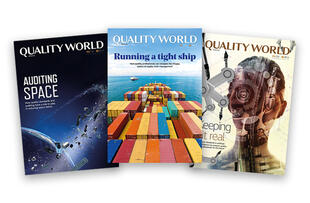
Culture is reflected in the rules
Progress indicator

Ryan Renard CQP FCQI considers the rules created by quality and how we perceive them.
When did you last stop to consider the purpose behind a rule you follow? Where did it originate, why, and – most importantly – is it still relevant?
This is one of the main challenges a quality professional will experience – conscious and wilful compliance. People do not arbitrarily follow rules without purpose or reason. This is before we start factoring in performance!
Perspectives on those rules cause significant variations of opinion. When they support our values or benefit us, we are inclined to have them upheld; but when they are against our values or diminish our possibilities, we seek ways around them, protest against them – or simply break them.
Quality, and the preferences promoted by the world around us, has created a litany of 'optional' rules. They are most present when working in, around, or contributing to industries, businesses, environments or practices. Where these are deemed important they become a regulation, where responsibility is to a legal authority such as a government.
These seemingly inflexible and rigid boundaries create a perception of inaccessibility to those that we want to inspire to follow and work within such rules. The issue isn’t having barriers to entry, it’s how they are perceived.
What are rules and why were they established?
Rules are contexts and boundaries established from our interactions with the world around us. They are there to minimise the risk of creating things we do not want and to maximise the chances of creating what we do want.
The word 'rule' has an inherently negative connotation precisely because of those boundaries they create. However, rules are precisely why we can interact with the world around us.
They manifest in various ways, through universal laws such as physics, personal laws imposed with self-discipline, and externally imposed laws from where and how we are born and live our lives. Without these structured guidelines, the world would be a chaotic and random. Every experience we have would be new – we’d spend most of our lives figuring out how to interact with everything.
"Clichéd as it may first appear, building the business you want to work in is precisely what we must all do to produce a quality culture."
The purpose of putting order in place is not to remove chaos, it is to give us a consistent perspective and baseline through which to interact with it. This concept is the foundation of scientific discovery; it isn't that we know we're right, it's that we're right to what we know at this moment in time. A little bit of knowledge isn't dangerous; what is dangerous is having a little bit of knowledge and being confident you cannot be wrong or that you know everything you need to know.
This is the reason standards were conceived, as a lens through which to view chaos and its interaction with quality.
We must also consider what happens when the wants and needs of others do not coincide with our own. Given true freedom, whose preference would become the priority? The simplest method to achieve harmony is to discuss together and put structures in place so that what is mutually agreed is achieved. This is very common within any collaborative or team effort; quality needs to be agreed to succeed.
Rules have been the foundation for knowing where the boundaries are and, most critically, how important they are to us when they are crossed. Not all rules are equal and we all place our values differently.
Rules and boundaries of quality
The ever-deepening complexity of our world demands that we write down our rules, even the subjective ones. Those subjective rules are our standards, spanning materials, processes, industries and other areas. Every step for progress requires the installation or change of infrastructures that enable progress to occur, and each of these also bringing with it another form of quality.
As shown with Plato's Allegory of the Cave, when we become unchained, we cannot experience the world and return without being fundamentally changed. Regression is no longer an option; when we experience what is, we cannot return to who we were before we knew.
In the closing of the allegory, the returning prisoner is treated suspiciously by those prisoners around him who think him harmed by his experience, thus unable to share the knowledge he has gained. In short, we are resistant to return to simpler times because of how our values and needs have changed as a species. We are fundamentally changed and desire control over things we can merely guide.
In the past, when we were hungry, we would hunt and gather. It cost us time and energy; we were often hungry, and it required a group of us to catch substantial volumes which we couldn't preserve. Now, in many countries, we can pop to a local shop and buy long-lasting products – it seems too simple. What we fail to notice is that those products are made through vastly complex processes, requiring hundreds of hours of work. Convenience may have increased, though the work has not– if anything, it has increased.
Humanity has created a complex and intricate network of interdependent systems that have enabled us to grow into the globally dominant species we are, with the physical capacity and capability of existing methods often being exhausted and new solutions requiring implementation. Each of these require standardisation to create consistency.
However – at what point will we have too many standards? How many rules can one person consciously comply too? Which ones sit at the top?
What does this all mean to quality?
In short, subconscious rules that are ingrained and incorporated into our person can potentially be limitless, and conflict between them decided by what that person values more. Conscious rules are far more difficult as they take time, effort and focus for us to remain compliant – particularly when we may disagree, or they do not align with our preferences.
Rules are vital for us to live and enjoy the world around us, though we rankle and rebel when they extend too far or are misunderstood. Quality standards are a self-imposed set of rules that go above and beyond what is typically expected of us day-to-day, though it is something we are often happy to impose on others to fulfil our goals and aspirations.
When you buy a product, you expect it to be good, what you need, and to the highest level possible, although the relevant price points may vary on where those expectations lie. But when is the last time you imposed the same expectations upon yourself? We find it far easier to justify our positions because we believe we all have mitigating contexts, and our lack of proximity and understanding gets in the way of us understanding others, particularly when they are large corporations.
The external quality culture of a business is reflected in its reputation; the consistency within which it meets the expectations of its customers. The internal quality culture of a business is represented by the self-imposed rules it applies; the consistency within which it meets the goals, aspirations, values and purpose of the company.
Both can be masked with marketing, reviews and carefully chosen metrics, though it is the internal quality culture that is uncovered most easily. We learn much by analysing and understanding which rules are valued, broken, ignored, and promoted.
What is valued is clear and evident with few deviations. What is broken will be routinely violated, with few people even being aware of its existence. What is ignored is the direct opposite of value; hidden, obscured and not recognised. What is promoted can either be a mask to which the company aspires, or the true goal.
How to tell the difference in the intention behind promotion? Look to the leadership – are they doing what they say, or saying what others should do? Where is the time in the company spent? Are decisions made in line with those promotions? This is the simple answer many give, though culture needs to be participated in by the majority, or it isn’t a culture. Look at the holistic picture and remember there is a difference between work as imagined and work as done.
Drawing conclusions...
Cultures cannot be measured, though like any pervasive factor in our lives, there are hallmarks, flags and indicators that show us what truly matters.
Clichéd as it may first appear, building the business you want to work in is precisely what we must all do to produce a quality culture. We are all responsible for holding ourselves and others accountable and creating an appropriate environment for everyone to succeed within.
Expect the most from ourselves while remembering you are human – in particular, remember everyone else is human like you too. Everyone is doing the best they can with what they have available.
What key elements of your business culture represent the true values of its workforce and leadership? More importantly, do they align with your own? What can you do to create a positive culture shift?
Read more from the author
Our environments are hallmarks of our behaviours, driven by our capabilities, beliefs and identity. When we strip back the guises of a business and unveil what is left, we find what culture has formed.
Quality World

Get the latest news, interviews and features on quality in our industry leading magazine.
Become an event partner for Quality Live 2025
Raise your organisation's profile with our audience of international quality and auditing professionals



